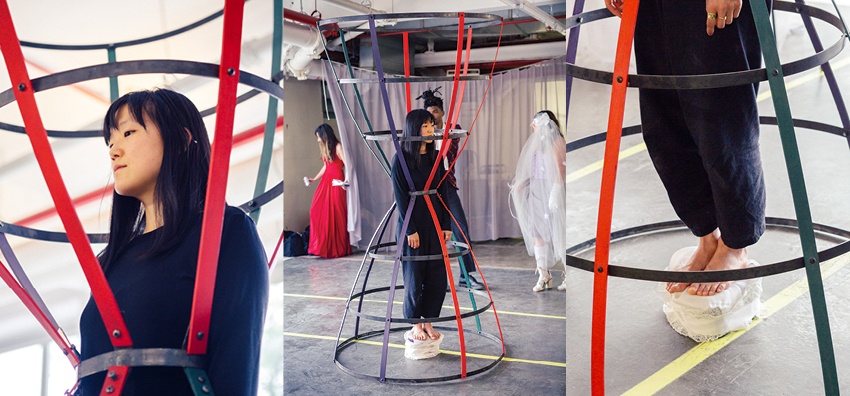
From the pages of Prattfolio, this article is part of a series of conversations between faculty and students on the subject of student work. This installment features Jenny Lee, Adjunct Professor CCE, Fine Arts, and Connie Fu, MFA Painting and Drawing ’19.
In Jenny Lee’s Welding, Metal Fabrication, and Forge course, graduate painting student Connie Fu explored the material world beyond the canvas to create a structure for a living sculpture, presented in the performance and exhibition Lust for Life: A Wedding, put on last spring with fellow Fine Arts MFA students.
JENNY LEE: Can you start by telling us why you took the course?
CONNIE FU: I had a lot of ideas about building structures and sets—I was swept up in this world of puppetry, the idea that there’s a body that is not fully autonomous. I was thinking, what if the [puppet] strings are a structure. I was looking at the theater of Robert Wilson [BFA Interior Design ’66] and thinking, using steel is the most commonsensical way to build structures that can support weight and that can also be formally beautiful and stark. I wanted to make those things—in addition to also building the confidence around working in the metal shop and interacting with the technicians.
JL: I want students to come away with a command of the processes and the materials, but moreover, I look for how they use the materials and the processes toward a larger purpose. Even though it is a techniques course, technical proficiency is secondary to critical making. Most of our conversations, amid highly technical, specialized shop talk, dig into thought process and judgment.
CF: I had this idea, but it was in an early stage. There were so many questions that I registered as anxiety. You were very careful, saying, let’s try not to get in the weeds about every little thing when you’re still at the concept level.
JL: It’s a holistic development that I’m interested in, being able to visualize something and then breaking it down intellectually and coming up with a strategy that is suitable for you to get there. There are many ways to get there.
CF: The process is very slow, especially as compared to painting—my approach to painting. But nonetheless, I could see quite tangibly that there were things happening and problems being solved every week. The other thing that kept me committed was that I really like this object. It’s a mirrored image with this kind of violent-looking center-waist construction. I like the fact that it’s a cage, but when you put it on it gives you definite personal space.
JL: Did you have to change your plans at any time?
CF: There were a couple of moments that were a little bit of a stutter. Really this waist component, where all the pressure is. There was no plan for it until the end. It was actually good that way, because I think if we had tried to plan everything out at the beginning, it would’ve been an additional obstacle to working.
JL: It would’ve been overwhelming. Because the class is for beginners, I have the approach that taking on an entire process from start to finish might not be feasible. So identifying and working through problems is central to the course: this requires assessment and choosing what to pursue and what to abandon, and to what extent. You gain knowledge and independence, you gain the ability to solve problems only by working through them.
CF: [Looking at images from the performance] I was thinking maybe I should document it in the traditional way—against a white background. The thing about this space I was in is that there is a lot of competing visual information.
JL: The lopsidedness becomes enhanced because of all the lines, horizontal, vertical.
CF: It bothered me at first, but one way to think about it is as a gesture of the sculpture, that it was never meant to be so perfectly precise.
JL: When you were making this, your main concern was that the rings were not close to perfect circles. I said, what’s more important is when you line them up, they should all be level, very still.
CF: After I welded the nuts on the back, I think that actually changed something.
JL: I think securing the nuts by welding torqued the structure.
CF: Yes, so that’s something I have to figure out now. I’m excited to continue to work through this and other projects involving structures, motion, and the body in Independent Study with you this fall.
JL: I am also excited to continue our dialogue, Connie, and look forward to your breakthroughs.
This article was originally published in Prattfolio (Fall/Winter 2018). Read the issue at www.pratt.edu/alumni.